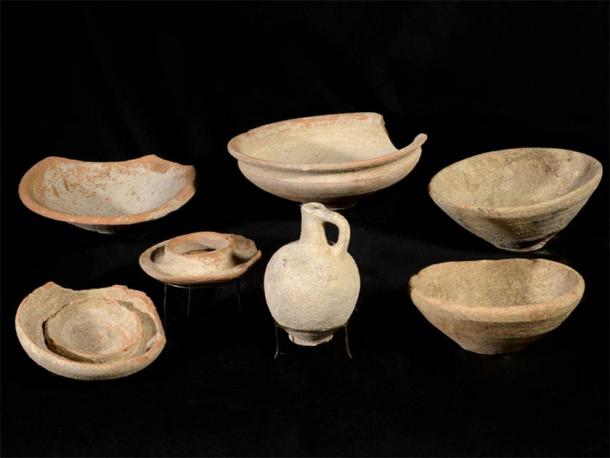An ancient Canaanite stronghold has been unearthed in Israel. It is believed to date back to the time of the Judges whose history is recounted in the Bible. The discovery is telling experts a lot about the ancient Canaanites and Philistines and the politics and wars in the period of the Judges.
The fortress is in the Guvrin forest, in southern Israel. It was uncovered by professional archaeologists from the Israel Antiquities Authority (IAA) and some teenage volunteers, who were participating in the program before their military service. The made the discovery near the Kibbutz Galon, not far from the town of Kiryat Gat .
Canaanite stronghold
The size of the Galon fortress, as it is known, is 54 feet x 54 feet (18 x 18 m) and it is located on a hill that overlooks the area. The walls were high and there were four watchtowers, one at each corner. A massive rock weighing up to three tons was found at the entrance and was probably a threshold. The IAA spokesperson notes that ‘Inside the fortress was a courtyard paved with stone slabs and columns in the middle’. This yard was covered by stone slabs and there were probably columns in the center.

A sketch of a 3,200-year-old citadel unearthed near Guvrin Stream and Kibbutz Gal On
(Image: Itamar Weissbein/ Israel Antiquities Authority )
There were rooms found flanking both sides of the courtyard. Many artifacts were uncovered in these rooms, which included living quarters and storerooms. Archaeology News Network states that some bowls found were ‘made in a style copying Egyptian bowls.’ Some earthenware vessels were found miraculously intact and ‘Archaeologists believe that they were used for worshipping local gods’ according to the Jerusalem Post .

A selection of the 3,200-year-old bowls found at the site. (Image: Dafna Gazit, Israel Antiquities Authority )
Wars and invasions
The Israeli Foreign Ministry reports that ‘The fortress structure, called Egyptian ‘governor houses,’ is known from other sites excavated in Israel’. This suggests that the fortress was built by Canaanites in the 12 th century BC. The Canaanites were a Semitic speaking people who controlled much of what is now Israel, Palestine, and Lebanon in the 2 nd century BC. This fortress dates to a dramatic and violent period in the history of the ancient Near East.
The 12 th century BC coincides with the period known as the Late Bronze Age collapse. Ancient Egypt had controlled many of the Canaanite settlements and city-states but because of foreign invasions and internal problems, they were greatly weakened. According to the IAA Spokesperson, ‘two new players entered the game: the Israelites and the Philistines’. This led to a series of violent territorial disputes.
Israelites, Canaanites, and Philistines
The Israelites had moved into the area occupied by the Canaanites and their Egyptian allies. They had formed a settlement in the highland area, and they were ruled by Judges, who were military and religious rulers, before the emergence of the Israelite monarchy. The Old Testament shows the Israelites battling the Canaanites under the Judges, and we are told that they exterminate them. In reality, the Israelites were intricately linked to the people of Canaan and were deeply influenced by their culture and society.
The Philistines began to settle on the southern plain of what is now Israel. Their origin is unknown, and some believe that they settled in the area after they had been defeated by the pharaoh during an invasion of Egypt. It is often supposed that they were one of the Sea Peoples who are often blamed for the collapse of Near Eastern societies during the Late Bronze Age collapse of the 12 th century BC. There is even a DNA study that places their origin in southern Europe.
The Philistines established a small kingdom called Gat and it was bordered by a small Canaanite kingdom known as Lachish which was probably an Egyptian vassal. The fortress was probably part of the Lachish kingdom and was built to control a key valley. It was likely used to keep the Philistines at bay. However, when the Egyptians left the Canaanites were unable to keep the Philistines at bay and they eventually devastated the Canaanite kingdoms.
[embedded content]
Geopolitics of Ancient Near East
At the same time, as this was happening, we know from the Bible that the Judges were fighting both the Canaanites and Philistines. Saar Ganon and Itamar Wesbin, archaeologists with the IAA told the Jerusalem Post that ‘The fortress that we unearthed allows us to glimpse into the geopolitical environment depicted in the Book of Judges, in which Canaanite, Israelites and Philistines were clashing with each other’. The situation in the area was extremely complicated and very bloody. Archaeology News Network reports Ganor and Weissbein, as saying that ‘the stories of the judges in the bible clearly demonstrate the complicated Geopolitical reality and the struggle for the control of territories during the establishment of new political powers in the land of Israel’.
The discovery of the fortress is providing a window into the era when the Israelites and the Philistines were establishing themselves in what is now Israel and the end of the Canaanite presence in the region. The fort has been opened to members of the public, thanks to a collaboration between the IAA and Jewish National Fund (KKL). It is in an area of great natural beauty.
Top image: Canaanite fortress found in excavation in Guvrin forest, in Southern Israel. Source: Emil Aladjem, Israel Antiquities Authority
By Ed Whelan
Related posts:
Views: 0
 RSS Feed
RSS Feed

















 August 29th, 2020
August 29th, 2020  Awake Goy
Awake Goy  Posted in
Posted in  Tags:
Tags: 
















